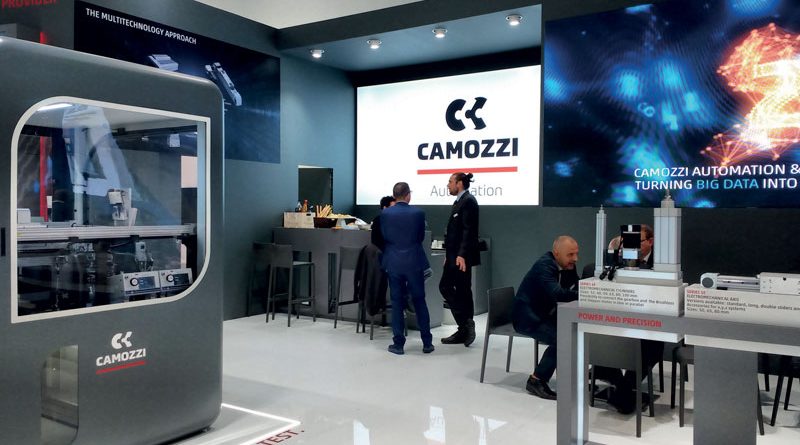Testing Valves is Smarter Than Ever
ATE (Automatic Test Equipment) is an automatic test station, used to test its own valves, which Camozzi presented at the recent SPS IPC DRIVES Italia trade show. Extremely flexible in its configuration, this station provides an example of interconnection among its components, the cloud and predictive diagnostics.
by Silvia Crespi
During the latest edition of SPS IPC DRIVES Italia, Camozzi Automation and Camozzi Digital once more presented solutions which they developed in synergy. The outcome of this fruitful cooperation is the main exhibit presented at the trade show: an automatic testing station (ATE, Automatic Test Equipment), developed to test the company’s own valves, which represents a complete cyber-physical system integrating on board the most evolved smart components for IIoT designed within the Camozzi group.
For the moment this is a product meant for use within the company, but it goes to show the group’s willingness to provide increasingly integrated systems, capable of “giving back” to the client data and information which are useful to monitor constantly the performances of their production processes, planning maintenance activities more efficiently and reducing considerably idle times and management costs.
Every datum, once collected, becomes useful to implement the corporate MES, thereby reaching a threefold objective: optimizing the process and quality of Camozzi’s finished products, implementing increasingly accurate and reliable calculation algorithms, and returning to the clients a real added value deriving from the digitization of their internal processes.
Extremely flexible in its configuration, ATE is an example of interconnection between its components, the cloud and predictive diagnostics.
Smart components are used in the station’s sections
ATE (Automatic Test Equipment) is an automated work station installed at the end of the production line to carry out testing of the finished product, in this case, valves. Let us examine the different sections which make up the machine and the components used in each, starting from the item storage.
The up/down movement for loading/unloading the stored valves which need to be tested is managed thanks to electrical axes in the 6E Series, with stepper engines controlled by the DRCS Series drives.
The movement of the trays from the section with items waiting to be processed to the section with processed items occurs by means of a rodless cylinder (52 Series) helped by a parallel clamp with a wide opening (CGLN Series). Before the start of the tests which will verify its correct electrical and pneumatic functioning, each valve is labelled with a unique QR code, so that each successive phase may be associated with that ID to define the “history” of the valve itself. Even in this case several component some into play, such as, actuators with an integrated guide (QCBF Series), short-stroke cylinders (QPR Series), suction cups (VTCF Series) and a vacuum generator with a control system and integrated valves (VEC Series) to pick up the labels from an automatic label feeder. The rotating table which moves the valves away from and towards the labelling apparatus is managed by a rotating cylinder (69 Series), a drive with integrated guide (QCB Series), anti-rotation rails (45 Series), mini-cylinder (25 Series) and decelerators(SA Series). Let us now go on to the electrical control, carried out on 100% of the valves produced, ensuring that these have the correct power absorption, and actually function within the declared power range.
Correct contacts during the test phase are ensured by the TWIN cylinder (QX Series): the double piston in a single body, besides being a property which offers a solid and effective drive, provides twice the force in a limited space. Cylinders in the QX Series are the ideal solution in applications where high force, precise movement and integrated anti-rotation and driving functions are necessary.
The pneumatic test phase concludes the testing of the valve by verifying the tightness of all the elements of the valve at the maximum pressure within the declared range. For this purpose actuators (QCB Series) are used, combined with a simple effect compact cylinder (31 Series), dedicated to the control of the manual intervention of the valve. Junctions, tightness valve pressure regulators and silencers complete the setup of the pneumatic test section. The movement of the valves from one station to another is carried out with a Cartesian system made up of electro-mechanical axes, electrical cylinders and clamps.
Data relative to the tests are integrated with the company’s MES
At the heart of the machine, the drives (DRCS Series) for stepper motors for the storage handling and the Cartesian system are found, distributed over the various electro-mechanical actuators; a set of “smart components”
such as the D Series valve island, the multi-serial CX Series module and electronic regulators in the PRE Series implement the different communication functions between the PLC and the PC for the machine’s management, regulating the air flows appropriately and communicating
using the WLAN and fieldbus systems
(for the model in the CX Series) the data gathered during functioning, thereby allowing predictive maintenance of the components themselves.
Finally, on board the machine, two PC panels control the management of the machine and the collection of testing data respectively, integrating them with the company’s MES. The data collection and processing system has been developed by Camozzi Digital and represents a complete and smart cyber-physical system, which can share information, generate the action required and control and modify the test parameters to optimize the process and the quality of the finished products.

